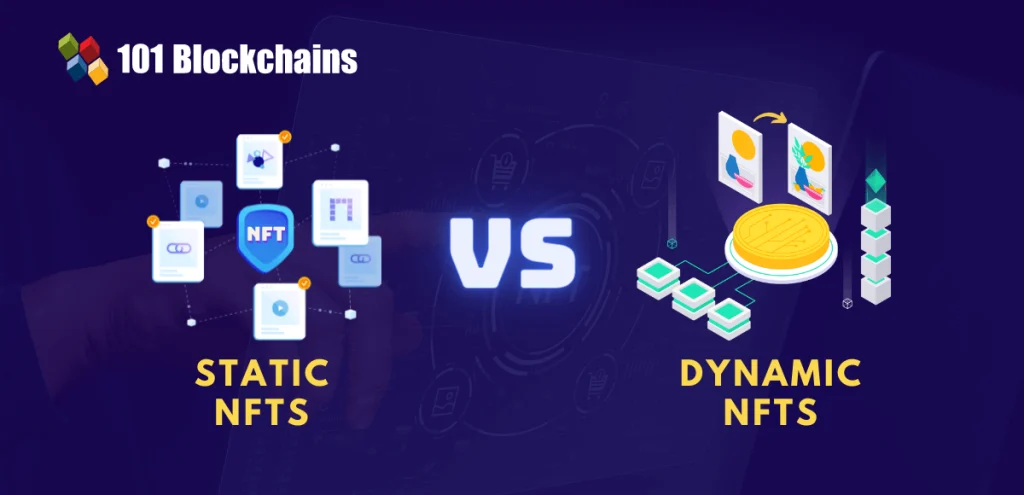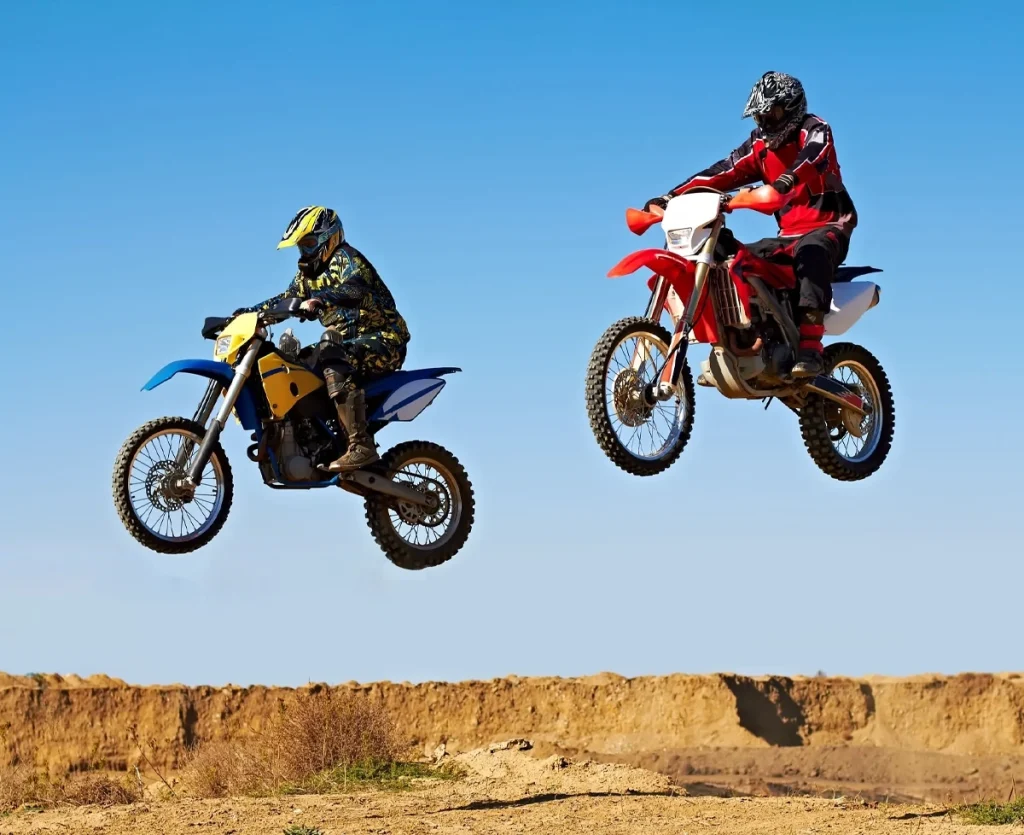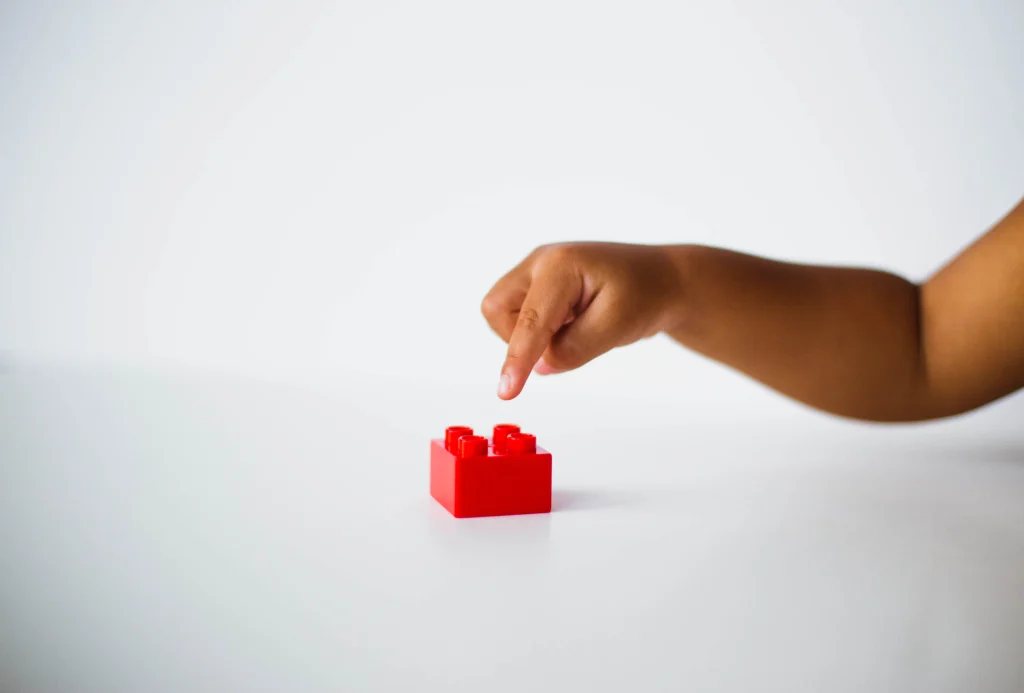Definition of dynamic NFTs
Dynamic NFTs (dNFT), also known as programmable or interactive NFTs, are a type of non-fungible token (NFT) that can change or respond to various inputs, conditions, or external factors, allowing for interactivity and evolution over time.
Unlike traditional NFTs, which are static and represent a fixed digital or physical asset, dynamic NFTs incorporate programmable features and functionality, making them capable of modifying their appearance, content, or behavior in response to specific triggers or actions. This interactivity can be harnessed for a wide range of purposes, from artistic expression and storytelling to gamification and real-world impact, making dynamic NFTs a versatile and engaging form of digital collectible or art.
How does it work?
Since the smart contracts are tools for carrying out a sale agreement on one’s own without the assistance of a third party, it gives feasible access for dynamic NFTs to evolve utilizing both off-chain and on-chain calculations.
Every time a NFT request is made, smart contracts analyze both on-chain and off-chain data to come up with an answer that is displayed to the users. The basic procedure might function as follows:
- A smart contract is initially contacted with a request for an NFT.
- The smart contract receives the request and processes it.
- The smart contract requests on-chain data and then handles the responses.
- The contract handles the outcomes after making a call to an oracle for off-chain data.
- Data from both the on-chain and off-chain are assessed. The smart contract then gives the requestor their choice of media one or two.
- Read more: How Does NFT Marketplace Work?
Benefits of dynamic NFTs
Greater engagement from users
The major advantage of a dynamic NFT collection would be the improved interaction from users. The interest of users in the upcoming modifications to the collection or project can be sparked with the aid of dynamic NFTs. For instance, new challenges with associated prizes as well as fresh ways to get involve with the collection can increase user participation.
Adjustable monetization services
Successfully increasing the number of users of dynamic NFTs would also provide new revenue streams for the dynamic NFT content. For instance, dNFT collecting may include fees for prizes or access to premium, exclusive content. Spending more time on the dynamic NFT website or app will increase the likelihood that users will choose the premium services, improving the opportunity for monetization.
Enhanced loyalty

People may discover new ways to appreciate the collections as a result of their ongoing involvement with the content of dynamic NFT initiatives. Therefore, marketers might deploy dynamic NFTs to turn their customers into devoted followers. Users are more likely to spread the news about a project when they interact with dynamic NFTs.
Immersive experiences
With various initiatives, dynamic NFTs may offer the benefit of immersive experiences. Users would continually seek out new experiences to have with dynamic NFTs, which would encourage them to invest more time in a particular solution.
The influence of innovation
The possibility for innovation is one primary advantage of dynamic NFTs. Flexible dynamic NFTs allow for the development of novel content production and distribution techniques. Examples of dynamic NFT collection show how projects may be customized to increase participation at the same time. As a result, there are countless alternatives available to every user when it comes to creating dynamic NFTs using their own creative ideas.
How to create dynamic NFTs
Because smart contracts enable NFTs to evolve, update, and grow over time, depending on off-chain and on-chain data, smart contracts can decide if a non-fungible token should change, together with the metadata of a dynamic NFT.
When creating dynamic NFTs, the process basically entails gathering off-chain data from your smart contract and transferring it to Chainlink before updating the NFT for the minting and final sale. Here is a general guide that you may follow on your own.
Step 1: Collect Off-Chain data
The NFT’s smart contract must first import off-chain data from the Chainlink oracle in three stages:
- Chainlink Price Feeds: You may get the most recent pricing for the assets in your smart contract.
- The Chainlink VRF: This technique consumes randomness in your smart contracts.
- The Chainlink Contract Library: You may use this function to request and receive data from an API.
Step 2: Feed data for smart contract query
After successfully bringing off-chain data into your blockchain, you can query the data stream from your smart contract. Before proceeding with the minting process, it is accessible to modify your NFT assets in accordance with the precise values provided by the Chainlink oracle.
Step 3: Submit your dynamic NFT
Start the minting process once moving the off-chain data on the blockchain and changing the NFT assets. You would have created a dynamic NFT after finishing the minting process. To sell it, just host it on the online marketplace of your choice.
What are the applications of dynamic NFTs?
Here are some most pratical and common applications of dynamic NFTs.
In Sports

Using sports collectibles, sports may include dynamic NFT aspects. Major League Baseball (MLB) dynamic NFTs were introduced by Candy Digital as digital collectibles with the title MLB ICON Leadoff. Dynamic NFTs are used on the players’ individual NFT collections as their numbers improve over the course of the season.
It is difficult to modify a player’s statistics while using static NFTs since the information was set in stone when the token was produced. When having a dynamic NFT, for instance, that represents a football player, the metadata of the dNFT might comprise data on attributes like strength, speed, agility, assists, goal scores, etc. The users would have the opportunity to obtain off-chain information and update the metadata based on the player’s performance.
Additionally, by adopting dynamic NFTs, sports collectibles can open up additional possibilities. The dNFT owner has the ability to forecast potential outcomes, such as a player’s season-ending performance. The person who made the most accurate predictions will see an upgraded avatar.
In Games

There are three typical types of games that can benefit from applying dynamic NFTs.
- The games with in-game characters: The dynamic NFT’s metadata is updated when a new in-game character first shows on screen. The information updates the modifications to confirm the character’s evolution if it develops and improves.
- Play-to-earn games: P2E games have been popular over the past few years. As dynamic aspect of NFTs is becoming popular, the distinctive in-game items like in-game money, power-ups, and virtual products are widely distributed. Additionally, the NFT armor or weapon may be upgraded via the add-on-trait function. When the NFT sword is repeatedly used in combat, for instance, its potency may increase.
- Fantasy game about sports: The distribution of NFT among players depending on performance is another potential use. For instance, the NFT is immediately given to the winner if the owner loses a combat.
In Art

The digital representation of art is yet another potential dynamic NFT usage. Dynamic art adapts or alters its characteristics in response to changing conditions. You may experiment with different methods of showing digital art in addition to constantly changing art presentations. Think about a collection of dynamic NFT artworks that change color or hue in response to location, season, temperature, lunar position, or time of year, as well as certain time-bound aspects.
Similarly, you may relate the artwork to the creator’s life or alter the pictures and music in accordance with a user’s purchasing history or other criteria. It implies that the owner collaborates in the creation of a dynamic work of art.
With government
Theoretically, the government may issue passports by utilizing dynamic NFT features that alter a person’s trip data. Since a person’s travel history is recorded on the blockchain, no papers or stamp would be necessary. Additionally, because blockchain makes the information verifiable and unchangeable, the likelihood of fraud is reduced.
With fundraising
In terms of fundraising, dynamic nft projects might appear more appealing. For instance, Regenerative Resources, a corporation working to convert damaged land into fruitful marine landscapes, used five short films as dynamic NFTs to raise money to protect mangroves. Each short film would initially only include one frame, but as the token is purchased or sold again, further frames would be made available until the holder may see the complete film.
Examples of dynamic NFTs in real life
One of the first instances of a dynamic NFT is the unique piece of art Crossroad by Mike Winkelmann known as Beeple. It was designed with the intention of altering its look according on the outcome of the U.S. presidential election in 2020. The image was altered to depict former President Donald Trump tumbling to the ground after Joe Biden won the election.
In 2021, with the aid of the NFT platform from Galaxis, Playground Studios introduced LaMelo Ball Collectibles. This official dNFT collection honors the NBA Rookie of the Year, integrate on-chain sports data and adjust in response to a game’s outcome. For instance, certain NFT avatars in the collection could change to represent a player scoring more than 1,000 points in a season. Notably, the Gold Evolve NFT had a clause that said the dNFT will change into a new design if Ball were to win Rookie of the Year for the 2021 NBA season.
Another illustration of a dynamic NFT is the well-known NFT-based video game Cryptokitties. Players may purchase, sell, or breed virtual cats in it. Each cat has a dynamic NFT that allows its owner to update some information about the animal, including the cat’s DNA, personality, and looks.
Static vs Dynamic NFTs – The differences
Static NFTs are often produced in accordance with a regulation, sometimes referred to as a token standard, which makes sure that every NFT has a distinct token ID after minting process. The metadata of an NFT contains details on the NFT’s characteristics, such as name, description, and transaction history.

Although an NFT’s metadata may be altered after it has been created, doing so can be a challenging and time-consuming process that needs coding expertise. As a result, many existing static NFTs and have characteristics that cannot be changed.
For instance, no matter how much time passes or how many times it changes hands, the digital picture and the data connected with it will remain the same if you mint a rare, one-of-a-kind piece of art as an NFT.
A dynamic NFT, on the other hand, is a sort of NFT that adapts to outside factors. The token, which is often referred to as a “living NFT” has properties that can alter in response to an occasion or accomplishment. The token’s appearance may also change as a result of the change to the NFT’s information.
If you play video games, for instance, your NFT avatar may be set up to adapt to your progress in the game by changing how it looks.
Although the unchanging NFT model has been widely used in play-to-earn games, digital collectibles, NFT art projects, etc., its utility can be restricted for projects that need to routinely update their metadata, such as assets from the real world, fantasy sports leagues based on blockchain, and progression-based video games. The idea of dynamic NFTs enters the play at this point.
Final thoughts
Even though the concept of dynamic NFT is still fresh up until now, it holds the ability to improve the NFT industry by offering a wide range of application scenarios and increased web3 sphere capacity. As a result of the success of these live tokens, dynamic NFTs may explore more breakthroughs and develop brand-new potential application.
If you want to know more about dNFTs’ unlimited ability and how they could alter your future business, get in touch with Synodus immediately to find out the best way to advance these tokens.
More related posts from our Blockchain blog you shouldn’t skip:
- The Complete Guide of How To Find The Best NFT Developers (2025 Edition)
- How to create your own NFT Marketplace (10 steps with tutorials)
- How To Start NFT Business With These Brilliant Ideas
How useful was this post?
Click on a star to rate it!
Average rating / 5. Vote count:
No votes so far! Be the first to rate this post.




